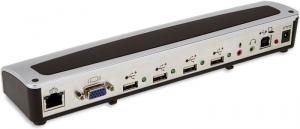Reviews by category
Increasing Notebook Connectivity
Buy Now...


click image to enlarge
Notebooks, due to their size, have limited opportunities for various ports and input/output sockets when compared to their larger desktop brethren. One solution to help ease limited connectivity would be to invest in an expansion dock. Falling into this category is the Kensington Notebook Expansion Dock with Video product.
One advantage of this a piece of equipment, apart from increase connectivity option, is that you will be able to move the notebook without need to disconnect the various peripherals that are attached to the dock. You simply just disconnect the dock.. Opening the box revealed the silver and black expansion dock, USB 2.0 cable, power adapter, software CD and a poster-sized folded Quick Start Guide. The combination of the expansion dock’s reasonable compact size (250 x 70 x 58mm) and the 172cm USB lead should ensure that any difficulty in positioning this dock, with regards to easy access, would be kept to a minimum.
Before attaching the expansion dock to the notebook, you will need to install the supplied software. This process might require a system restart but not necessarily. However when you first connect the dock via the supplied USB lead, you will need a system restart.
All the various connections are contained along the back of the dock – maybe not the ideal location for easy access but it does help keep the cables out of the way. Sitting next to the power connection socket is the USB upstream port. Continuing along the back are headphones and microphone sockets, four USB 2.0 downstream ports, VGA video output port and a 10/100 Ethernet port. Apart from the USB lead to connect the expansion dock to the notebook, you will need to provide all the leads.
As mentioned earlier, the expansion dock comes with its own power lead. While some of the connectivity options should work without power, the dock’s video capabilities will not be supported unless power is provided. It was noticeable that the expansion dock quickly became warm to the touch but, fortunately, not excessively so.
When setting up the various connections, especially those relating to the video capabilities, you really need to access the PDF version of the User Manual as the Quick Guide is extremely basic in content. Fairly comprehensive details are provided for the Extended (dual mode) when you split the display across two screens or Clone mode giving identical displays on two monitors. The expansion dock supports resolutions up to 1400 x 1050 with 16 or 32-bit colour depth.
I did encounter one aspect of the expansion dock that failed to produce the desired, in fact any, response. While I was able to record audio, although at a lower volume level than when using the notebook’s own microphone input connection, I could get no audio whatsoever when using headphones with the expansion dock. The PDF User Guide offered no help. It explained what to do if the notebook’s internal speaker failed to work (this was not a problem to affect the test system) but offered no solution for getting audio output from the expansion dock. As yet I have not been able to solve this problem.
The Kensington Notebook Expansion Dock with Video needs to be attached to a system with a 1.2GHz processor, 512MB of RAM and 30MB of available hard disk space running Windows XP and later. Expect to pay in the region of £100 if you fancy adding to your notebook’s connectivity options.
| add to del.icio.us | Digg this review |
| StumbleUpon | |













 !!
!!










